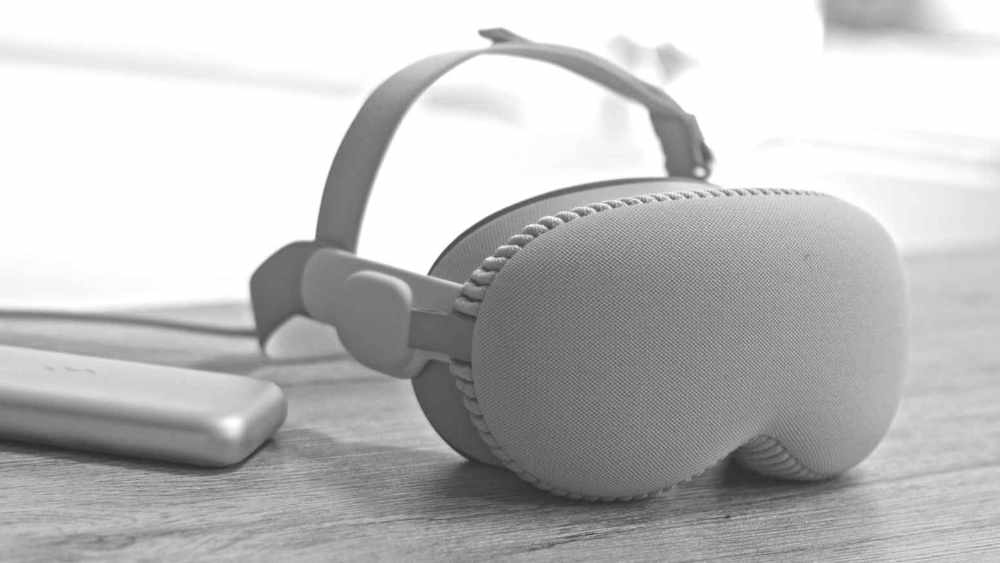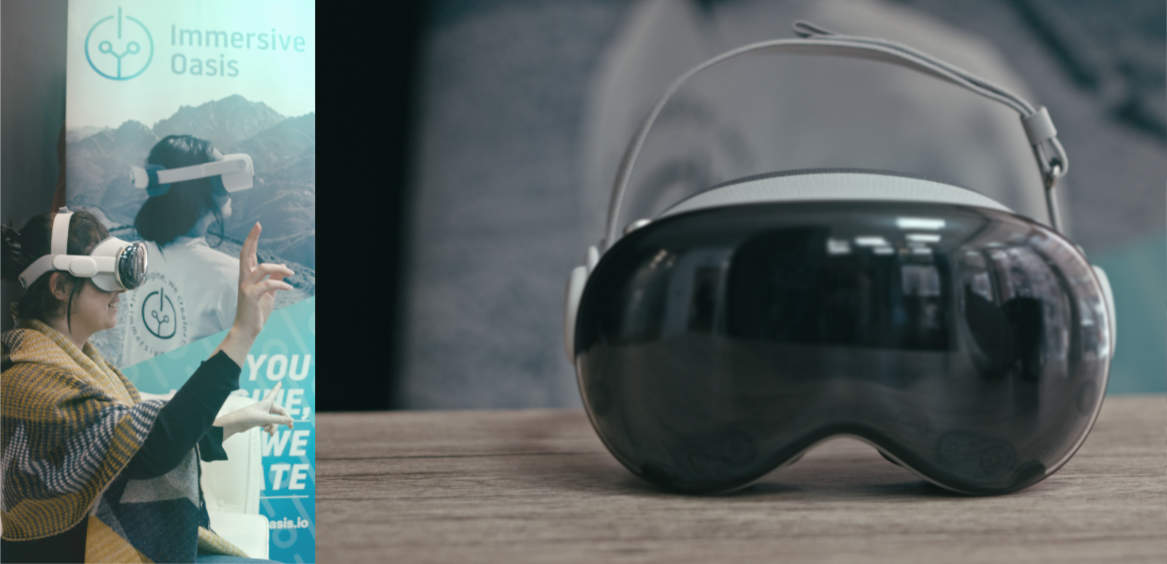
Several weeks have passed since Apple’s latest disruptive device arrived for the general public. This device is the Apple Vision Pro, an extended reality headset that opens the doors of the Apple ecosystem to the nearly limitless capabilities that this type of technology brings us.
In this article, we’ll try to clarify what this headset is and what it is not, the environments in which it can serve a clear purpose, and therefore, also those aspects in which they falter. Behind these lines is an experienced team of people who work with these type of devices every day, typically trying to push their capabilities to the limit. A team that has worked with all virtual reality headsets to date, some are old enough to have known Nintendo’s famous Virtual Boy, so you can expect a useful and honest opinion.
💡 Additionally, the original text is being written from a Vision Pro connected to a MacBook.
If we use pure objectivity, focusing on the device itself, we could say that the Vision Pro has no direct competitor. Its hardware features, price, or usability make this device completely unique and without direct competition.
Therefore, to talk about competition, we have to broaden the scope through which we view the device market. To evaluate the competition, we have taken into account the following aspects:
Based on these three points, we currently have two competitors in the market for Vision Pro: Meta and Pico.
For convenience and market size, we will focus the comparison on Meta Quest 3 and Pico Neo 4. These two devices are practically identical in their characteristics, so, without wanting to fuel the eternal debate too much, for convenience, we will call them the Android alternative.
The truth is that the Android alternatives may fall behind in hardware, and we could say that their user experience is different (in this aspect, it is important to understand that they also target a different market audience), but we cannot really say that they fall behind in functionality. In some cases, they surpass them. Again, it’s important to understand that they target different audiences and use cases.
Android alternatives have focused on one thing to date, the gaming user. All sales messages, content, or price (around $500) are focused on the gaming market, although there is another side focused on businesses (B2B). In contrast, Apple Vision Pro already makes a target difference just based on its price, $3500 vs $500. Such a difference already makes it clear that they are not targeting the same audience, purely based on purchasing power.
If the price aspect is not one of the differential factors for your project or idea, let’s delve a little deeper into what we can do with them and what we cannot.
Let’s start with the simple part of this section. Leaving aside Apple’s proprietary issues such as spatial videos or the headset’ handling system (things that are already seen in Android alternatives), there is nothing you cannot do with Apple Vision Pro that you cannot do with Android alternatives.
💡 Important note: Apple’s device is very new, its maximum capacity has not yet been reached, and possible accessories that could extend its functionalities have not been seen. Therefore, this part may change over time.

Let’s dive into this in a simple and schematic way:
With these devices, you can mix digital elements with the environment around you. Project elements onto the floor, in the air, modify your view of your surroundings such as changing walls, ceilings, and floors… In short, add another layer of digital information to the real world.
To do this, extended reality devices have a series of cameras with which they analyze your space and others with which they make a live video of your environment and show it to you on the screen; this is called passthrough. Here we have to give a campion to our friend Apple. Their passthrough system is not worse than competitors, nor is it particularly better; what is clear is that comparatively, this aspect leaves a bad taste in the mouth when considering the price. However, we have been able to make a typical Spanish omelette with the glasses on.
Apple doesn’t compete here. It’s true that the device can switch between a passthrough mode and an immersive mode. Even we, as developers, can force the operating mode of an application to only act immersively. But virtual reality, at the technological and market point we are at right now, involves more things.
In the current market, both gaming and professional, virtual reality tends to require certain complex interactions and movement. You don’t always have to be walking or standing, but if we think of virtual reality, you probably think of Beat Saber or Fruit Ninja, perhaps the typical example of firefighting or medical training. For all these types of activities, you need to move, you need some agility, and especially if the experience involves moving a character, you need joysticks. And this is where Apple’s big bet falls short, probably because it’s not the market they want to address.
Its main drawback in this regard is the lack of controllers that allow those more complex interactions, or movement within virtual environments in an immersive way, although through gestures movements could be performed. However, they have another handicap in this regard, which is their external battery. Having the battery hanging, besides affecting its ergonomics – which we’ll talk about later – is a bit dangerous if you’re making movements. Fortunately, no one on the team has had anything serious happen with the battery, but we’ve had some scares.
The first thing to say in this topic is that Apple itself includes, for free, a strap that is not the one shown in all its marketing campaigns. This can already give you an idea that Apple knows that they haven’t made the most ergonomic device on the market.
This is probably the most subjective point of all, so perhaps you’ll have a different experience if you use them, but they are not the most ergonomic device on the market. In this aspect, Pico continues to have the best-balanced devices “out of the box,” followed by Meta and the countless accessories that allow improving the experience of wearing these devices for hours.
Apple Vision Pro is heavy, and all the weight is on the front part of your head, which generates some tension in the neck when trying to maintain an upright posture. Even with the ergonomic strap included by Apple, they are not a device to wear during long sessions.
Regarding the mask and the comfort of the eye area, they have something different.
Although it is not something that is especially noticeable in the FoV (Field of View), the area of the lenses is smaller than that of Android alternatives. It gives a feeling of “diving goggles” that can sometimes be somewhat uncomfortable and in some team members has resulted in visual fatigue.
Where they stand out is in the quality of their screen. It would be unworthy of Apple not to release a device with a spectacular screen, and here the Vision Pro does not fail. They are the standalone device with the best image quality we can find on the market. Also, its immersive audio capability stands out, leaving Meta Quest 3 behind in terms of its surround sound quality and overall sound quality.
The key to this entire article is the following: do this headset serve to meet my needs? To answer this question, it would be best to tell our team what you need, and we will be happy to help you.
What we can tell you in advance is that the Vision Pro is designed, for the moment, as a single-user device. It is not a comfortable device at an event. The need for the system to measure the distance between eyes and the calibration of your movements for correct and fluid operation can make showing your products to long lines of spectators a frustrating and tedious task that can ruin your perfect marketing strategy by the device.
Similarly, if what you need is hardware that several people can use, regardless of whether they wear glasses or not, and that is always available to each user, you have the same problem, it is not a device designed for sharing. You may encounter people who, due to diopters or the morphology of their face, Apple glasses are not the best option.
As we mentioned in previous sections, if you need virtual training experiences or environments where immersion involves more complex interaction than touching or rotating objects, they are not the best device either.
Finally, if what you are looking for is high-quality visual and sound hardware that can be useful in travel situations, where it is not always easy to have access to large screens for work or the privacy of a closed office, undoubtedly, Apple Vision Pro is the device you were looking for. A good travel companion for those who are not sure on which side of the bed the light switch is and who are wary of their privacy in different aspects of their work.
Do not hesitate to contact us if you have any doubts about how immersive technologies can help in your business, or what hardware can best adapt to your needs.
